New York Reasserts Its Historic Leadership as a Haven for Immigrants
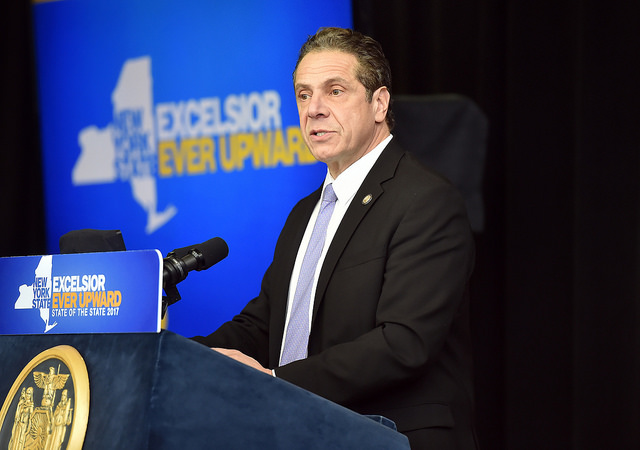
Governor Andrew Cuomo (photo: Kevin Coughlin/The Governor's office)
New York Governor Andrew Cuomo has joined the chorus of criticism against President Trump’s ban on refugees and other immigrants from seven predominantly Muslim nations. “I never thought I’d see the day when refugees who have fled war-torn countries in search of a better life would be turned away at our doorstep," the governor said in a statement following the president’s executive order. "We are a nation of bridges, not walls, and a great many of us still believe in the words 'give me your tired, your poor, your huddled masses...' This is not who we are, and not who we should be.”
Mario Cuomo strikes a resounding chord
Andrew Cuomo's support for immigration and diversity echoes the sentiments of his father, former Governor Mario Cuomo, who served from 1983 to 1995. The elder Cuomo was the first Italian American elected as governor of New York State. He had no tolerance for prejudice and worked tirelessly for human equality and dignity. A champion of recognizing merit regardless of sex or race, he appointed the first Black, the first Latino, and the first two women judges to the state's Court of Appeals.
In talking about immigration issues, Mario Cuomo often recalled the story of his parents, Andrea and Immaculata Cuomo. Penniless and unable to speak English, they had come to the United States from the Italian province of Salerno, south of Naples -- Andrea in 1926 and his wife a year later in 1927. After spending three years in Jersey City, they moved to the Queens neighborhood of South Jamaica, where they opened a grocery store and raised their family.
By that time, there were thousands of Italian Americans in New York. But across the nation, there was lots of prejudice against Italians for their religion (mostly Catholic), speech (most learned English, but often it was not perfect) and culture (they retained some old country ways but assimilated into their new land and were proud to be Americans). Congress enacted laws in 1921 and 1924 to cap total annual immigration and impose numerical quotas based on immigrant nationality that favored northern and western European countries. The laws were directed against Italians and others from southern Europe. “The old belief in America as a promised land for all who yearn for freedom had lost its operative significance," with the passage of these laws, wrote historian John Higham in his book “Strangers in the Land: Patterns of American Nativism, 1860-1925.” It had been replaced by a "new equation between national loyalty and a large measure of political and social conformity." By the time Mario Cuomo's parents arrived, a few years after the restrictive legislation, the flow of southern and eastern European immigrants had been greatly reduced.
National immigration policy continued to change and became more open in later years. But Mario Cuomo, born in 1932, remembered the sort of prejudice his parents faced and fought it his entire career. For him, it was a personal matter as well as a matter of public policy.
In a 1992 speech at New York University, Cuomo decried "nativist sloganeering and parochial fear-mongering that's been aimed at every group of new immigrants throughout our history." He recalled his parents' lives. "I thank God the country didn't say to them 'we can't afford you right now; you might take someone else's jobs, or cost us too much,'”, he said. “I'm glad they didn't ask my father if he could speak English, because he couldn't. I'm glad they didn't ask my mother if she could count, because she couldn't...I'm glad they didn't ask my father what special skills he brought to this great and dynamic nation because there was no special expertise to the way he handled a shovel when he dug trenches for a sewer pipe. I'm glad they let him in anyway."
Cuomo worked to rally the Democratic party for the cause of immigrants. "We speak for the minorities who have not yet entered the mainstream," he said in his address to the 1984 Democratic convention. "We speak for ethnics who want to add their culture to the magnificent mosaic that is America."
Andrew Cuomo continues a New York tradition
Speaking at the 2016 Democratic National Convention last July, Andrew Cuomo sounded a similar note. "The Trump campaign is marketing a great distraction, using people’s fear and anxiety to drive his ratings," he told the delegates. "Their message comes down to this: be afraid of people who are different — be afraid of different religions and different colors and different languages. Stop immigration and they believe the nation will automatically rise. It’s not right, it’s divisive, it’s delusional, and we must expose the truth to the people of this nation. Unless Republicans are all Native Americans, then they are immigrants too."
In a speech this past November, Andrew Cuomo asserted that he and New York will fight against the spread of anti-immigrant fear. Like his father, he put it in personal terms. "If there is a move to deport immigrants then I say start with me,” he said. “I am a son of immigrants. Son of Mario Cuomo, who is the son of Andrea Cuomo, a poor, Italian immigrant who came to this country without a job, without money, or resources and he was here only for the promise of America."
Cuomo intends to make good on his promise to protect immigrant rights. He has ordered his counsel's office to explore legal options to help anyone detained at New York airports to ensure their rights are protected. Promising more action, on January 29 he said, “As New Yorkers who live in the shadow of the Statue of Liberty, we welcome new immigrants as a source of energy and celebrate them as a source of revitalization for our state. We will ensure New York remains a beacon of hope and opportunity and will work to protect the rights of those seeking refuge in our state."
New York -- Land of promise
The fight over refugees and immigrants is likely to be a spirited one. The Trump administration promises to strengthen restrictions and ramp up stringent vetting of foreigners who want to enter the country. New York State seems likely to insist on continuing its historical tradition of welcoming newcomers. New York has led before and will again this time. It is a natural role for our state, particularly since New York City is where more immigrants have entered the nation over the years than at any other place.
Immigration policies varied over the years, but many of the immigrants have had one thing in common - aspirations for a better life. "More than anything else, the immigrants come with dreams -- dreams that hunger might become a thing of the past, dreams that restrictions and discrimination might be replaced by rights, and dreams that poverty might be traded for security and opportunity, if not for oneself, then at least for one's children or grandchildren," writes Andrew Anbinder in his new book “City of Dreams: The 400-Year Epic History of Immigrant New York.” He continues, "These dreams characterized the New York immigrant story from the arrival of the first Dutch settlers through the heyday of Five Points, the Lower East Side, and Little Italy. Those same dreams dominate the lives of New York's newest immigrants, whether they are Chinese or Guyanese, Jamaican or Dominican, Mexican or Ghanaian. The story of immigrant New York is truly a story of dreams."
***
Dr. Bruce W. Dearstyne's latest book is The Spirit of New York: Defining Events in the Empire State's History, published in 2015 by SUNY Press.
***
Have an op-ed idea or submission for Gotham Gazette? Email This email address is being protected from spambots. You need JavaScript enabled to view it.
State Legislators from New York City Should Not Be Bagging the Bag Fee
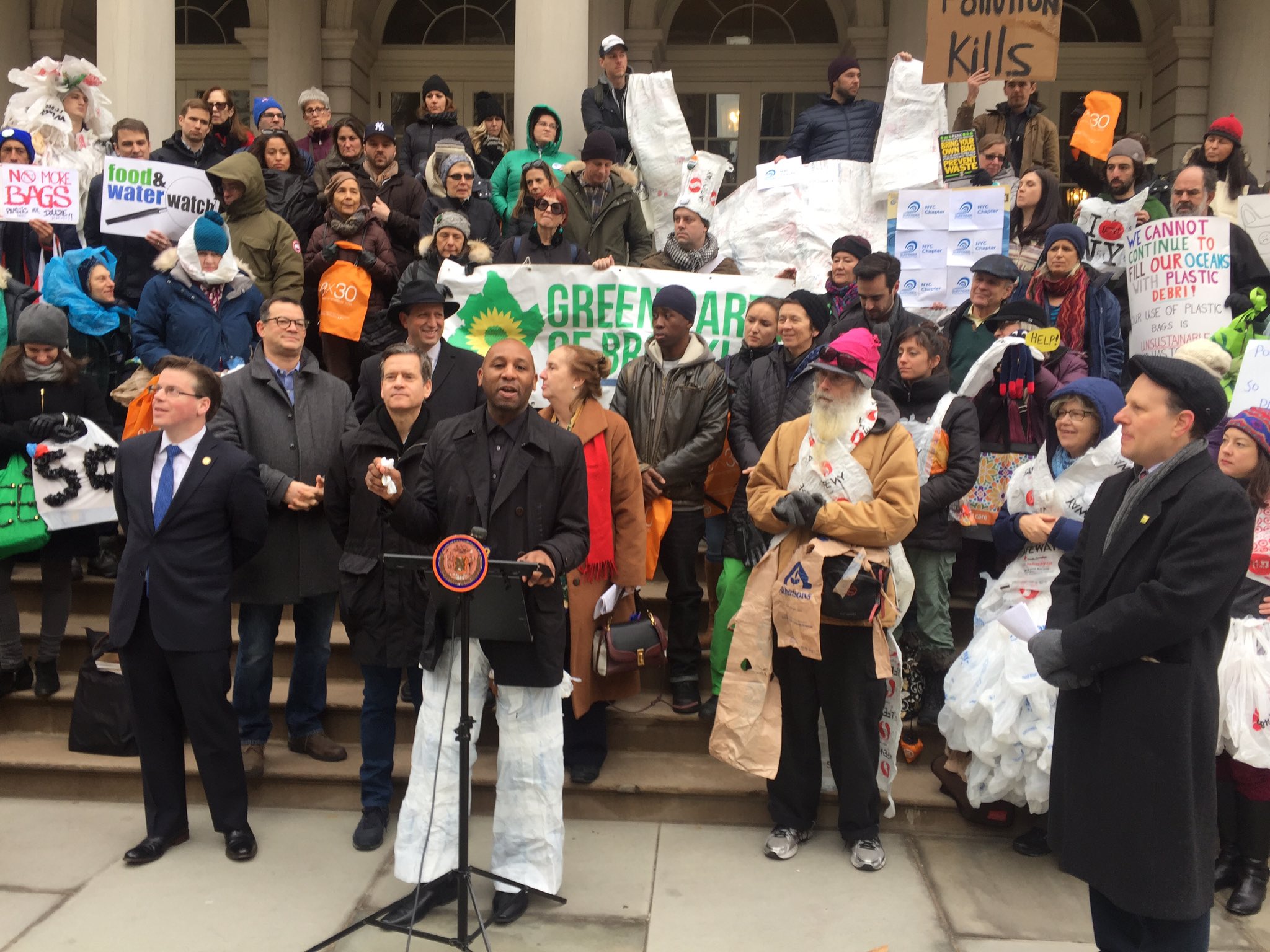
Elected officials and advocates rally outside City Hall (photo: @bradlander)
New York City is trying to do something about plastic bags, but my state Assemblymember is attempting to undermine the city’s ability to do so. He, along with many of his NYC-based colleagues, are acting against their own constituents’ interests. This is a normal New York State versus City story, but in a moment where the stakes of politics are high because the federal government’s threats are real, this battle between city and state feels more offensive and disheartening than ever.
The story today is that New York City passed a law last year that requires most shops to charge a five cent fee for each carryout bag a person takes when shopping. However, in January, the state Senate passed a bill to say, “Sorry New York City, we don’t like that bill so we’re going to kill it.” The state Assembly, rather than deny the Senate outright, chose to punt and delay the implementation of the city’s law for one year. As of publication, Albany’s compromise would require a new City Council to vote on the carryout bag fee a second time, after different Council members are elected for a 2018 term.
The state Legislature's actions are a structural problem, a political problem, and a problem of spirit in these times.
Structural problem: The state constitution has a problem, because it does not stop the state Legislature from having so much influence over the way the city governs itself. Even though the state constitution provides us the right to make our own laws through the so-called home rule provision, the Legislature is very good at getting around it. Lawmakers often use the language, “In cities with a population of more than one million...” as the preamble to a law intended to impact one city. There is only one city in this state that falls into the category of more than a million people. Although this current block of the bag bill might not be constitutional, the state Legislature knows they have a lot of precedent telling them that they might be able to do this. We could change the state constitution to protect the city’s home rule powers, but not with the Legislature guarding this power so jealously.
Political problem: The state Senate is very confusing. There are more Democrats than Republicans, by one senator. That senator, a Democrat named Simcha Felder, spends his time with the Republicans and does not work with the Democrats. He is proud to be a Democrat in name only. There are also a group of eight Democrats called the Independent Democratic Caucus (IDC) who work with the Republicans, giving the Republicans an effective supermajority. They appear to hate this bag bill, and so they easily gave the Republicans in the Senate the power to undermine New York City’s desire to take another step toward a better environment. Most of the IDC is made of Senators who represent the city.
Spirit of resistance problem: We need to take every stand we can to resist the current White House. This means that our state should be standing proud and together to show the federal government that we care about better environmental law and policy. Seeing Assembly members from the city fighting with the City Council by effectively wagging their legislative finger is not the message we should send right now. I want to see my state legislators prioritizing their energy by improving our healthcare laws here, our worker protections here, and our environmental laws here. All of these policies are under threat or attack from the federal government.
This is why I can’t understand why my Brooklyn Assemblymember, Walter T. Mosley has not publicly stated his opposition to this bill. The state Legislature should support New York City and work together right now for the good of us all. Every environmental advocacy group in the city supports this bill. And most of the time, my Assemblymember supports the progressive legislation that his constituents expect of him. Every New York City-based state Legislator should be with their constituents on this right now and show their spirit of resistance in all forms.
***
Richard Semegram is a tenant lawyer, his Twitter handle is @richagram
***
Have an op-ed idea or submission for Gotham Gazette? Email This email address is being protected from spambots. You need JavaScript enabled to view it.
The Governor’s Essential Investments in New York City

Gov. Cuomo and the NYC REDC (photo: The Governor’s Office)
If we learned one thing from Donald Trump’s election it’s that our country expects its leaders to prioritize job creation and strengthening the middle class. Earlier this month Governor Cuomo outlined a new budget that invests in just that by prioritizing infrastructure, education, and entrepreneurship in a way that is both positive and forward thinking. For New York City, this is the strongest budget we have seen from Albany in decades.
In New York and across the country, high-quality education was always the great equalizer. Access to a good school, regardless of your zip code, provided a pathway to higher learning and a gateway to opportunity. With an additional $1 billion in new funding for schools statewide, including a $294 million increase in in New York City alone, the governor’s budget will improve academic institutions across the five borough for millions of students.
From increased support for vital pre-kindergarten programs, especially for those in high-needs districts, to increasing access to Community Schools, which are transforming high-needs schools into community hubs, and expanding the Empire State After-School Program by more than a third, New York State is ensuring all our students have the skills they need to grow and succeed.
But we must also ensure students are able to climb the next rung on the ladder of economic opportunity. By 2020, New York City is projected to gain 284,000 jobs that require a Bachelor’s Degree or more, and an additional 201,000 jobs will require an Associate’s Degree.
For the jobs of tomorrow, a college degree will help provide the ticket of admission – and the governor’s new Excelsior Scholarship program will make this attainable for all New Yorkers.
Governor Cuomo has put forward an innovative plan to provide families earning $125,000 or less free college tuition at New York’s prized public institutions, CUNY and SUNY. Phased in over three years, the program will significantly expand college access for more than 940,000 families in New York.
To lead in today’s hyper-competitive global economy, we must have the best-educated workforce in the world. The life sciences sector in New York is poised for unparalleled growth and with a $650 million investment from the state, we will leverage research and laboratory space to create high-paying jobs, stay ahead of the cancer curve, and develop new technologies and treatments to combat all forms of disease.
The jobs of tomorrow also include a high-skilled workforce capable of building the new New York. Under Governor Cuomo’s $100 billion plan to transform our infrastructure, the Second Avenue subway has opened, and work continues on a new airport to replace LaGuardia and an expansion of the Jacob Javits Convention Center. The state is also rebuilding 33 subway stations and will be expanding Metro North Service to four new stations.
Residents of Queens and Long Island will particularly benefit from the work that will soon begin on the expansion of the Long Island Railroad and the new Penn Farley train station. The new JFK will dramatically improve the travel experience, and by expanding service on the AirTrain and eliminating traffic bottlenecks on the Van Wyck Expressway and at the Kew Gardens Interchange, it will be much easier to get to and from the airport.
In the Bronx, the state is allocating funds to transform the Kingsbridge Armory into the Kingsbridge National Ice Center, and to completely rebuild Orchard Beach's historic pavilion at Pelham Bay Park, adding a performance space and concessions. The state will also invest $50 Million to expand affordable healthcare in the Montefiore Health System, a leader in the governor's health care delivery transformation strategy.
In Brooklyn, Governor Cuomo has proposed a series of initiatives to address health and wellness, including increasing access to healthy foods; more nutritional programs; planting new community gardens and creating pop-up parks; and developing a community-based healthcare delivery-system which focuses on ambulatory and primary care. And in a step that will help address the city’s housing needs, the state will build up to 3,000 units of new affordable and supportive housing that will incorporate wellness-related features such as exercise rooms, rooftop gardens, and health clinics.
On Staten Island, the governor proposes to make permanent the toll reductions on the Verrazano-Narrows Bridge that the state temporarily enacted in 2014. Governor Cuomo will also take steps to explore transitioning the Institute for Basic Research in Developmental Disabilities, which is operated by a state agency, to CUNY, which should help ensure the long-term viability of that institution.
All in all, New York City will see all of these investments and over $400 million of net funding benefit from the state, dedicated to growing economic opportunity and leveling the playing field on behalf of all New Yorkers. Governor Cuomo’s is a budget that will help us build a better tomorrow, and deserves everyone’s support.
***
Winston Fisher is Co-Chair of New York City Regional Economic Development Council & Partner at Fisher Brothers.
***
Have an op-ed idea or submission for Gotham Gazette? Email This email address is being protected from spambots. You need JavaScript enabled to view it.
Enacting a State Budget that Restores Opportunity
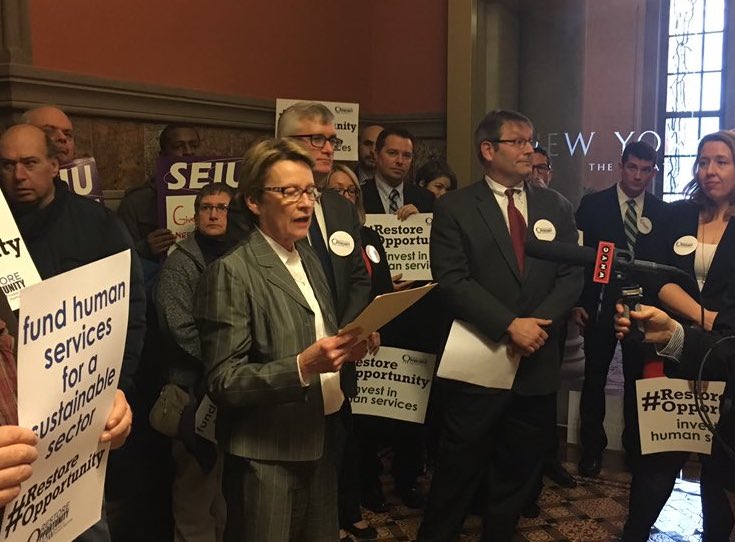
Seeking state budget changes (photo: Human Services Council)
Today -- Thursday, February 2 -- at 1 p.m., Urban Pathways, human services leaders, workers, and clients from downstate New York will gather at our Ivan Shapiro House, a supportive housing residence in Manhattan, to call on Governor Cuomo, the Assembly and Senate to strengthen the human services sector through cost-effective investment. We will also respond to an Executive Budget released by Gov. Cuomo that is devoid of this investment.
In the Executive Budget, Gov. Cuomo laid out laudable proposals, including expansion of pre-kindergarten and afterschool programming, and addressing homelessness and the opioid epidemic. All have a worthy goal of increasing opportunity for individuals and families. However, the $152 billion budget plan invests little in the sector responsible for executing this vision: nonprofit human services.
For example, to address homelessness, the budget appropriates $950 million for the construction of 6,000 supportive housing units throughout the state. Yet, an assessment of how the governor’s budget invests in compensating those who provide the support in supportive housing - human services case managers, security, maintenance, and administrative assistants - shows glaring shortcomings.
The fiscal year 2018 Executive Budget briefing book put out by the Cuomo administration acknowledges our “nonprofit labor force includes a large number of low- wage workers.” However, the budget is devoid of a cost of living adjustment (COLA) for our workers, freezing their income as their housing costs only rise. The governor has recognized the increasing costs of housing, but his budget does not reflect how hard it is for some of the state’s most important workers to afford their own places to live.
The governor’s budget also eliminates the planned 0.8 percent human services COLA. It also discontinues the COLA enacted in 2015 to certain direct care workers and direct service providers.
The State did enact a phase-in plan for a $15 minimum wage last year, which we appreciate. Our workers should not live in poverty. However, the governor has yet to fund the minimum wage increase for human services workers under contract with the state, leaving our sector to absorb the cost. He acknowledged the economic hardship that the increase imposes, suggesting his budget division could grant organizations a state reimbursement based on hardship. The governor should provide the necessary budget dollars instead of requiring us to demonstrate hardship. This is about organizations doing the most important work being able to pay their workforce without having to lay off employees.
The budget fails to consider the long-term success of its proposals, shortchanging all New Yorkers. For example, the staff of the new supportive housing units works years without a cost of living adjustment, ultimately leaving to work for a sector with COLAs. This means another new case manager for our clients. This interrupts the continuity in the clients’ care and jeopardizes their path to self-sufficiency. It also costs the supportive housing provider to hire and train new staff, which impedes the delivery of services for the client.
Currently, over 340 human services organizations across New York State are coming together for the Restore Opportunity Campaign. The campaign asks for increased investment in our sector to ensure we can continue to effectively serve our communities. The campaign recommends Gov. Cuomo do the following:
1. reverse the trend of defunding human services programs;
2. fund the cost of the minimum wage increase for human services workers; and
3. continue to invest in the Nonprofit Infrastructure Capital Improvement Program.
Across the state, the Restore Opportunity Campaign is holding press conferences to stress that the state can do better for its communities. This past week, the Human Services Leadership Council of Central NY and the Southern Tier Independence Center held press conferences in Syracuse and Binghamton, two of several cities in the state with child poverty rates above 50 percent. The campaign has also held a press conference in Albany where one-third of households are rent-burdened, paying 30 percent of their income on rent.
This is the year to enact a state budget that restores opportunity for all New Yorkers. We urge Gov. Cuomo and the State Legislature to stand with us and communities by investing in the organizations that strengthen our state and people every day.
***
Nicole Bramstedt is Policy Director at Urban Pathways. On Twitter: @UrbanPathwaysNY.
***
Have an op-ed idea or submission for Gotham Gazette? Email This email address is being protected from spambots. You need JavaScript enabled to view it.
Responding to Trump’s Sanctuary City Threat
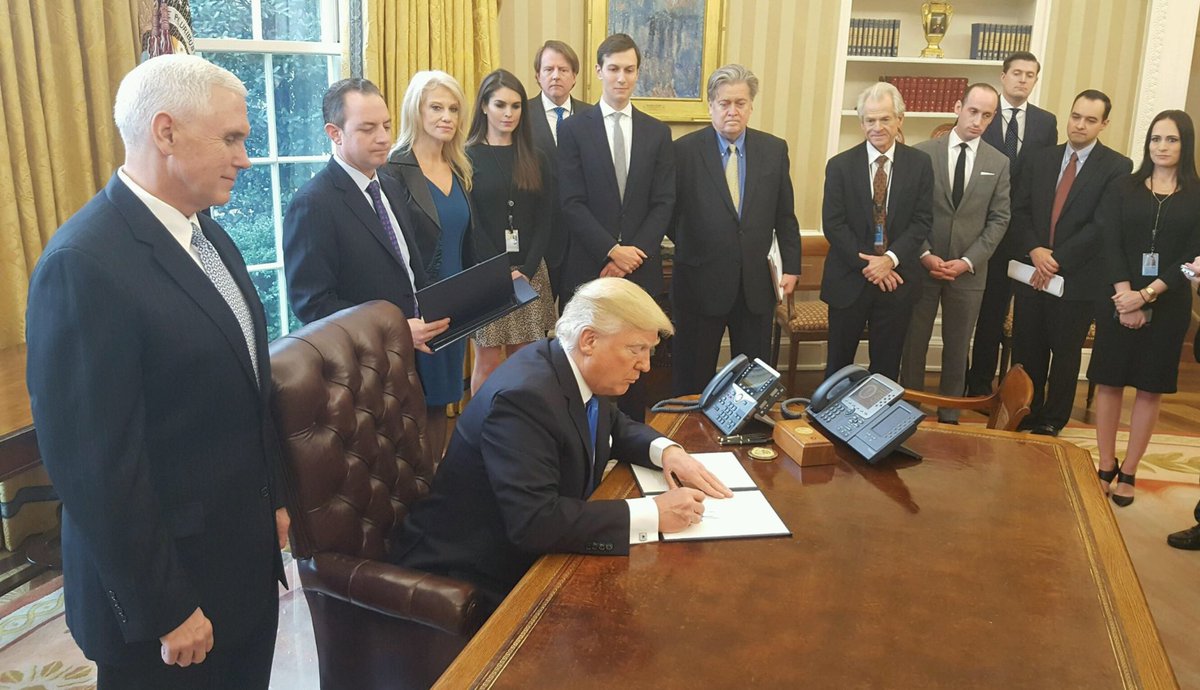
President Trump signs an order (photo: @realDonaldTrump)
One of President Donald Trump’s first executive orders is to declare war on 39 sanctuary cities – New York, Boston, San Francisco, Chicago, Seattle, Los Angeles, to name a few – and hundreds of other sanctuary municipalities and counties in the United States that are safe harbors for undocumented immigrants.
The threat is clear.
If our sanctuary cities do not enforce Trump’s executive order, by notifying federal authorities of undocumented immigrants accused of criminal offenses, a sanctuary city will lose federal funds, law enforcement funding and grants. For New York City, it could be billions of federal dollars.
Shockingly, in Trump’s world, the deportation process starts when an individual is “charged with any criminal offense and [even] when a charge has not been resolved.”
New York’s response to the president must be: Keep your money.
Mayor Bill de Blasio, standing with other elected and public officials – including the Police Commissioner – defiantly stated that New York City will not comply with this presidential order.
But, there has to be more than defiant rhetoric.
Missing at the mayor’s press event were the city’s district attorneys, who are charged with the prosecution of all criminal offenses. It will be the D.A.s – and to some extent the police also – if they comply with the executive order who will be required to notify federal immigration authorities of allegations, charged offenses, and the disposition of criminal offenses committed by undocumented immigrants, irrespective of the seriousness of the offense.
Consequently, if the executive order is enforced by our district attorneys, any charge will result in the detention and mandatory deportation of an arrested undocumented immigrant for nonviolent crimes or low level offenses, such as disorderly conduct, possession of small amounts of marijuana, a “quality of life” or “broken windows” offense. All of this occurring before an individual is found guilty of any offense.
In New York City, and elsewhere, prosecutors must not become part of Trump’s federal deportation squad. The district attorneys must reject Trump’s financial blackmail, and not comply with his unlawful, odious executive order.
By a stroke of the pen, Trump obliterated fundamental fairness, the presumption of innocence and due process -- something that prosecutors must not permit to happen, no matter who is charged with an offense.
Trump’s order also wilfully disregards existing federal law mandating that before deportation – for any offense, including “aggravated felonies” and other crimes – a conviction must first occur. Constitutional law is founded on the presumption of innocence and due process for all, including an undocumented immigrant who is arrested or accused.
With this presidential decree, Trump eliminated a trial or any semblance of justice before deportation. Now, an executive order accusation means “let’s kick them out,” because all undocumented immigrants or those who overstay a visa, he thinks, “present a significant threat to national security and public safety.”
The president also fails to realize his executive order has serious public safety consequences.
Under normal circumstances, police and prosecutors have a difficult time encouraging an undocumented immigrant who is victim of or witness to a crime to cooperate in an investigation. With the looming risk of deportation, a victim or witness fears assisting law enforcement. This will only increase under Trump’s policies as they are.
There is no question immigration reform is a complex issue. This executive order is not a step in the right direction, but just the beginning of a process to reshape our country’s immigrant landscape by diminishing civil liberties and constitutional protections.
Reform cannot be resolved with Draconian measures – arbitrarily barring entry, arrest, detention and deportation – because, in the president’s general opinion, “The presence of such individuals in the United States...are contrary to the national interest.”
We must never forget that every day the American flag proudly flies on top of the Brooklyn Bridge, Ellis Island, and Liberty Island where the Statue of Liberty stands as a beacon of freedom. These symbols are reminders of our history and fights to protect freedom and civil liberties no matter how an individual enters or resides in the United States.
Our sanctuary cities will survive and grow in defiance to Donald Trump’s belief that these cities – a hope to so many – “have caused immeasurable harm to the American people and to the very fabric of our Republic.”
Mr. President, you are so wrong.
***
Arnold N. Kriss is a Manhattan attorney and former Brooklyn Assistant District Attorney and NYPD Deputy Commissioner-Trials.
***
Have an op-ed idea or submission for Gotham Gazette? Email This email address is being protected from spambots. You need JavaScript enabled to view it.
Immediate Steps We Must Take to Protect Our Drinking Water, and Ourselves
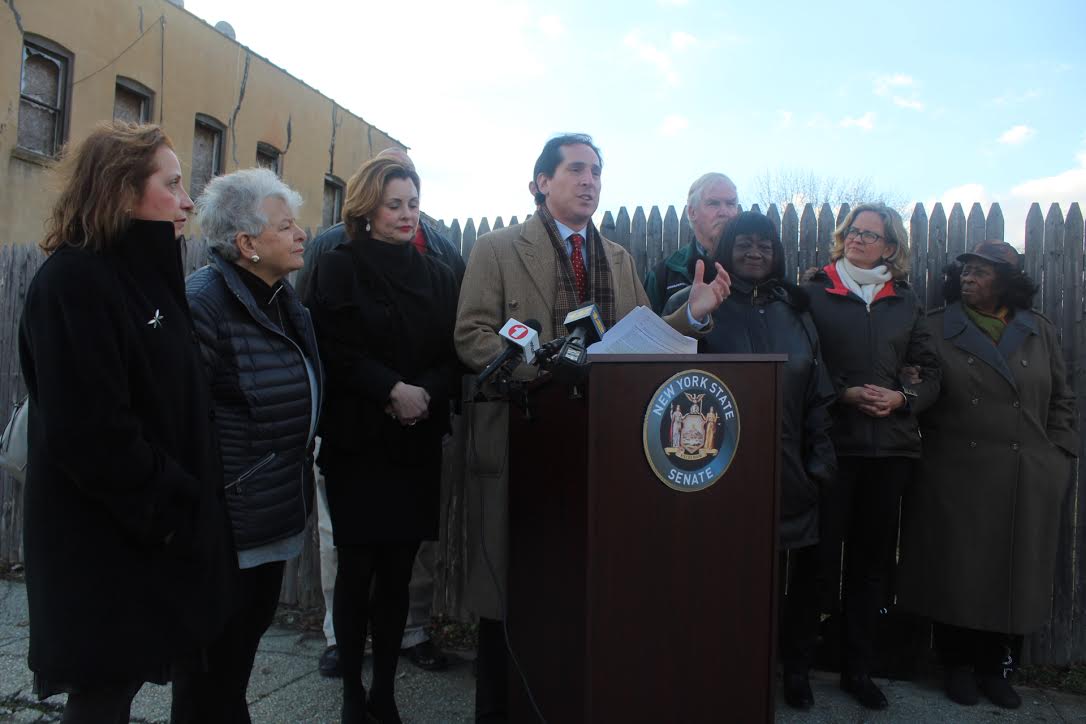
State Senator Todd Kaminsky, the author
New York State is facing a drinking water crisis and we cannot waste another moment in aggressively and adequately addressing it.
Close to home for me, recent reports that the Environmental Protection Agency discovered a dangerous chemical — 1,4-Dioxane — that is more prevalent in our drinking water here on Long Island than anywhere else in our state raise serious questions about our health and safety that must be immediately addressed.
Dioxane is a hazardous agent often used as a stabilizer for manufacturing solvents, and is present in many shampoos, lotions and detergents. Worse, it readily leaches from soil to groundwater, is resistant to biodegradation, and cannot be removed from water with conventional treatment technologies. An EPA report concluded that this toxin is “likely to be carcinogenic to humans" by all routes of exposure.
Whether it is Dioxane, other chemicals, lead, or bad infrastructure, all over the state we have water quality problems that require our immediate attention.
The time to act is now. All public institutions put in place to protect New Yorkers must marshal their resources to ensure we quickly learn the extent of this problem, create a plan to address it, and act swiftly to clean our drinking water however necessary, wherever necessary.
Let’s start today. Here’s how:
Pass legislation I put forth to direct the state’s health commissioner to immediately conduct a comprehensive health review of 1,4-Dioxane in our water and set a specific limit for this dangerous chemical. Currently, there is no specific standard for the amount of 1,4-Dioxane allowed in our water, which means it automatically defaults to a catch-all standard, which is way too high.
Develop technology to remove 1,4-Dioxane from our water. There is a pilot program underway in Suffolk County to do just that, which must be expedited and expanded.
Approve Gov. Andrew Cuomo’s proposal to invest $2 billion in critical clean water infrastructure across New York. Water treatment can cost nearly $1 million to rid each contaminated site of 1,4-Dioxane -- a bill local municipalities simply cannot afford to foot. The new funding stream would go a long way toward supporting the chemical-removing technology that we need.
Water is our most critical natural resource, and Long Island relies heavily on its aquifer system to provide a clean and plentiful supply of potable water for our consumption. When we find out that the water we take for granted every day contains chemicals that can cause cancer, we must act without hesitation.
I will fight tirelessly and work with my colleagues from both sides of the aisle to procure the necessary funding for the surveying, planning, and technology to purge our water of harmful substances and restore it to the clean and safe state we deserve. For all of the taxes we pay, we Long Islanders deserve the most basic service a government can provide: clean and safe drinking water. It’s a necessity of daily life that all New Yorkers deserve.
***
Todd Kaminsky is the state Senator for New York’s 9th Senatorial District and was recently appointed to serve as the Ranking Member of the Senate Environmental Conservation Committee. On Twitter @ToddKaminsky.
***
Have an op-ed idea or submission for Gotham Gazette? Email This email address is being protected from spambots. You need JavaScript enabled to view it.
Planned Parenthood’s Message for Albany, To Be Delivered in Person
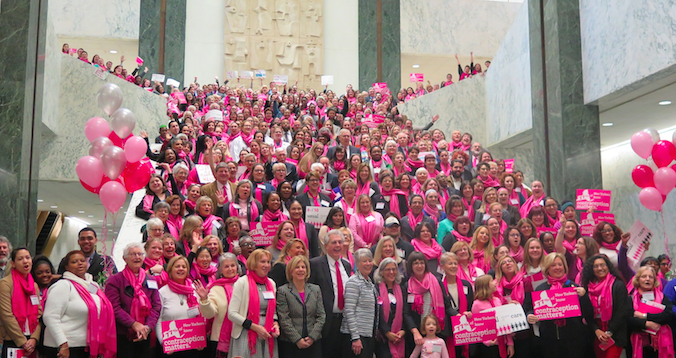
Planned Parenthood NYC
Many of us have been involved in national actions like participating in the Women’s March on Washington, but now more than ever, it’s just as important to take action at our state and local level. On Monday, January 30, dozens of Planned Parenthood of New York City supporters, volunteers, and staff are getting on a bus to Albany to demand that our elected officials protect New Yorkers’ access to health care.
In the midst of the worst assault on reproductive rights that we’ve ever seen, we need leaders that will stand up for reproductive health and rights. There are local steps that must be taken. Recently, in response to the demands of New Yorkers, Governor Andrew Cuomo announced bold action to enhance access to affordable contraception through insurance coverage.
While this is a great step forward, it’s also only the beginning. Right now, our State Senate majority is hostile to sexual and reproductive health issues, and has failed to enact crucial legislation that would protect New Yorkers’ access to care. Now more than ever, our elected officials must move to ensure that reproductive health is protected.
Here’s what we’ll be pushing for on Monday in the capital:
Protecting Planned Parenthood & Ensuring Continued Funding
Under the current federal administration, we are facing threats to funding for Medicaid and Title X, programs that we rely on to provide essential health care to thousands of New Yorkers each year. Losing funding would have a devastating impact on the communities we serve, particularly for women of color and low-income women. In 2017, we are demanding that our state’s elected officials stand with Planned Parenthood and reject any attempts at the federal or state level to restrict access to reproductive health care.
Ensuring Access to Abortion through the RHA
New York State legalized abortion in 1970, three years before the Roe v. Wade decision. But with Roe now at risk, New York must take additional steps to make sure that abortion access is protected. We must update three key components of our current law: first, the Constitutional protections of Roe v. Wade must be written into New York state law. Second, we must remove restrictions that criminalize abortion providers. And, finally, our law must reflect modern medical practice by allowing Advanced Practice Clinicians to provide abortion care. The Reproductive Health Act (RHA) accomplishes all these goals and should become law during this session.
Improving Contraceptive Access
The federal Affordable Care Act (ACA) made contraception more accessible than ever, but New Yorkers still face barriers in accessing the contraception they need. The Comprehensive Contraceptive Coverage Act (CCCA) ensures commonsense solutions so New Yorkers have the tools they need to lead healthy lives and fulfill their dreams. The CCCA removes out-of-pocket expenses for vasectomies and improves New Yorkers’ ability to access Emergency Contraception in a timely manner, in addition to provisions similar to those the governor has put forward.
At PPNYC alone, 64,000 New Yorkers rely on us annually for health care services. Our communities come to us for indispensable primary and preventive care, including contraception, breast and cervical cancer screening, pregnancy testing, STD testing and treatment, HIV testing, and more. And regardless of insurance status, immigration status, or ability to pay, we’re here for all people—no matter what. Time and time again, we have heard from patients and activists about the importance of being able to access affordable, high-quality care. Now is the time for New York elected officials to step up and protect access to health care, not just in New York City, but across all affiliates statewide.
The assault on reproductive rights will only intensify around the country, and New York has the unique responsibility to stay true to its progressive legacy. Now is the time to be a model for resistance. Now is the time for our elected officials to stand up for reproductive health and rights, and send a message that will resonate around the country: we won’t go back.
***
Joan Malin is President and CEO of Planned Parenthood NYC. On Twitter @PPNYCAction.
***
Have an op-ed idea or submission for Gotham Gazette? Email This email address is being protected from spambots. You need JavaScript enabled to view it.
When A Subway Swipe is Out of Reach
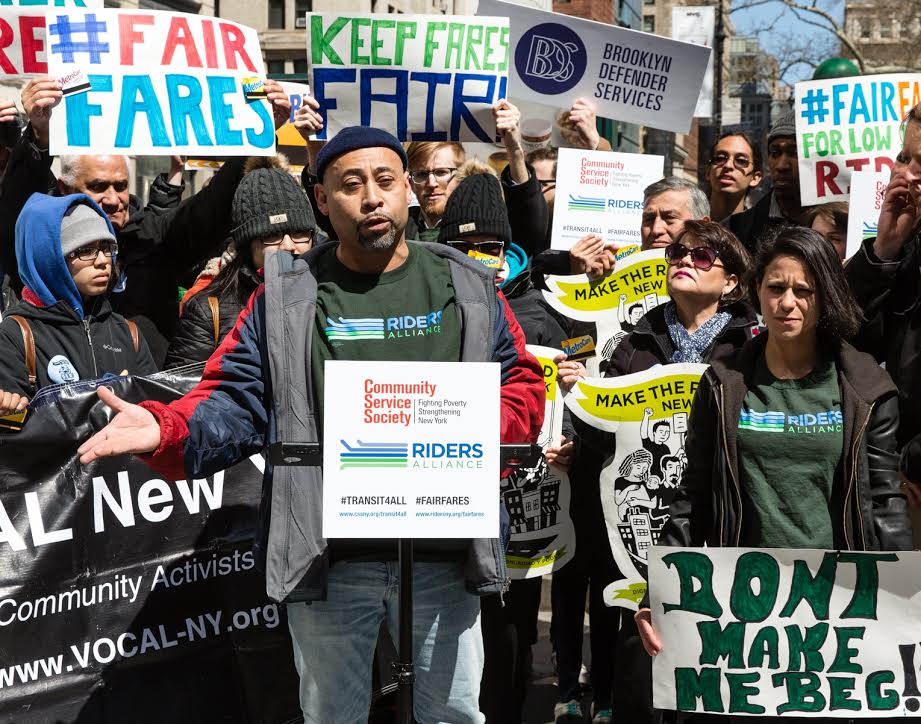
(photo: Riders Alliance)
Not long ago, as I entered the 149th Street and Grand Concourse station in the Bronx where I live, I saw a group of undercover police officers surrounding a young man under arrest for jumping the turnstile. As I stared, I remembered my own run-in with the cops for fare evasion. Seeing this kid get arrested, my mind returned to that moment: the cold metal of the grate against the back of my head, the suffocation of the officer's forearm deep in my chest, and my fear that my attempt to spare my mother’s health—however well-intentioned—might put my own well-being at risk.
Let me explain.
When I was in 7th grade I was accepted into Prep for Prep, a summer program that provides academic and leadership development opportunities for low-income kids of color. At 14 years old, I wanted nothing more than to sit around and hang out with my friends. But my mother understood the importance of this opportunity for a low-income black kid from the Bronx and insisted that I not let this pass me by. At her urging, I attended classes on weeknights and weekends in Midtown.
The program provided two-trip MetroCards, but because of bus transfers, they weren’t enough to get me there. To help out, my mother, who has multiple medical conditions that require her to take life-saving pills every day, would use savings dedicated to her medical bills to buy me a MetroCard.
It hurt me to see my mother make that sacrifice. No parent should ever have to choose between their health and a MetroCard for themselves or their family. But a lot of people make exactly these kinds of near-impossible choices every day to pay for their travel. In fact, a study by the Community Service Society of New York (CSS) found that one in four low-income New Yorkers reported being unable to travel to doctor appointments, jobs, and other necessities because of the cost of a MetroCard. The same report found that the cost of a 30-day unlimited MetroCard often makes up over 10 percent of a family's budget, forcing individuals to make painful sacrifices, including on essentials like rent, food, and other bills.
I saw my mother struggle with that decision every day—until the day when I decided I couldn’t stand to be the reason anymore. I lied and told my mother that I already had the fare to get to the program—and jumped the turnstile. I wanted to give my mom a break. I wanted to help her out for once after all that she had done for me.
Of course I was stopped by the cops. After a terrifying encounter, they let me off with a warning—but we all know that I was an exception to the rule.
James Baldwin once wrote in an article for Esquire Magazine, “Anyone who has ever struggled with poverty knows how extremely expensive it is to be poor.” This is certainly true in New York City, where, as CSS found, 58% of low-income riders rely on the transit system—but are all too often unable to afford to use it. This is the inescapable trap of poverty: the poor pay more for everything.
This is true of transit as well: we pay more for a single-ride MetroCard because the fare structure incentivizes buying unlimited monthly MetroCards. Those who can’t afford to shell out a lump sum of $116 (and rising) are paying more than the wealthier for their trip. We pay more because we don’t make enough to take advantage of the pre-tax transit benefits program middle-income and wealthy New Yorkers enjoy. And we pay more when we get caught begging for a swipe or jumping the turnstile -- we get fined hundreds of dollars, get carted off to jail, or worse.
Like my neighbors, I know all too well how poverty forces people to make tough, sometimes illegal, choices simply to get around. Unlike my neighbors, every fall I have a temporary escape from poverty. In no small part because of the opportunities that Prep for Prep provided, I’m a junior at Harvard University. College isn’t just a place to earn a better life for myself in the future; it’s also a reprieve from the chronic trauma of poverty and the exhaustion that comes from having to calculate the cost of every action.
That’s why I’m joining CSS and the Riders Alliance in the call for #FairFares and asking Mayor de Blasio and our City Council to fund half-priced MetroCards for low-income New Yorkers.
Public transit should connect every New Yorker to good jobs, affordable housing, and the rich cultural opportunities that this city allows young and eager minds like me. Hundreds of thousands of New Yorkers are left out of those opportunities—but we can change that if we make public transit truly accessible to every member of the public, including the poor.
If my mom hadn’t sacrificed for me, I wouldn’t be where I am today—but the point is that no one should have to make the kinds of sacrifices my mom made to help their kids succeed. With Fair Fares, 800,000 more New Yorkers could be eligible for half-priced MetroCards that could save them up to $700 a year. Imagine how many parents could help their kids thrive with these savings if the Mayor would stand up for every New Yorker’s right to access public transit?
***
Robert Rush is a junior at Harvard University. He grew up in the Bronx and is a member of the Riders Alliance, a grassroots non-profit that fights for better, more affordable public transportation in New York City.
***
Have an op-ed idea or submission for Gotham Gazette? Email This email address is being protected from spambots. You need JavaScript enabled to view it.
Fighting Back in the Trump Era

Corey Johnson, the author (photo: William Alatriste/City Council)
January 20 marked the beginning of a dangerous new era for our country. For the first time in many of our lives, we now have a president who rose to office on the power of racist, sexist, classist, and xenophobic campaign promises. These are promises he is already working to keep.
Of course, Donald Trump's agenda does not truly represent our nation. The day after his inauguration, millions of people marched in cities around the world to reject Trump’s divisive ideology.
The Women’s Marches on Saturday sent a clear message about where we stand as a people. But speaking truth to power is only the start. We must now organize our communities and engage with our democracy in unprecedented ways. The fates of our economy, our health care system, our environment, our national security, and our most vulnerable populations depend on it.
We can start by creating change right here at home in New York.
As Attorney General Eric Schneiderman recently put it, “When they go low, we go local.” Indeed, there’s an enormous opportunity to create change at the local level and ensure that our City and our State remain on a progressive course.
We have made great strides here in New York, from a rising minimum wage to a strong health care marketplace, and we will have to fight hard not to be taken backwards in the Trump era.
That is why I call on all New Yorkers to get engaged, get involved, and make sure that when local elections take place in 2017 and 2018, we choose representatives who are committed to executing your vision for our City and state. The New York State Senate, for example, is still controlled by Republicans, despite the fact that registered Democrats outnumber Republicans two to one. This should not be.
Nationally, 2018 will present us with an opportunity to elect federal representatives who can stand up to Trump in the halls of Congress. New Yorkers need not look very far for seats we can flip – a third of New York’s 27 members of Congress are Republicans!
It will take nothing short of an all-out blitz to turn many of these seats from red to blue, and we need to start organizing now. As the Women’s Marches showed, there is nothing like action. It is time for everyone who cares to be engaged.
While we act locally, we must demand that our representatives in Washington, D.C. cede no ground to Trump and his extreme agenda. As New York Congressman Jerrold Nadler says, we must not normalize his extreme views on issues like immigration, religious freedom, women’s rights, and climate change. Keep the heat on your federal representatives to ensure that they do not buckle in the face of pressure. Anyone who compromises on our essential values should not be re-elected.
Let your federal representatives know how you feel. As an elected official, I can tell you that these calls really do matter.
So step up and be heard. Take your rightful place at the forefront of our democracy. The election may be over, but it’s never too late for passionate and dedicated individuals to put our country back on the right path.
***
Corey Johnson represents District 3 in the New York City Council, which covers the neighborhoods of Hell’s Kitchen, Chelsea, the West Village, and parts of Flatiron, SoHo and the Upper West Side. On Twitter @CoreyinNYC.
***
Have an op-ed idea or submission for Gotham Gazette? Email This email address is being protected from spambots. You need JavaScript enabled to view it.
Teacher Certification and Recruitment: Boats Against the Current
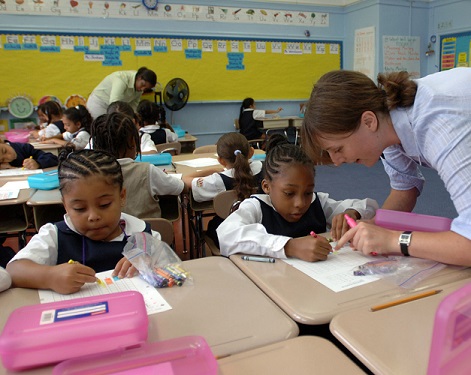
(photo: NYC DOE)
First, do no harm. Ha!
On Tuesday, the New York City Council will hold an oversight hearing on teacher recruitment and retention. The Council announcement states that a hearing is necessary because “there’s a growing teacher shortage across the United States, although it is impacting some states more than others. This is the result of a nationwide trend that has seen the number of college students enrolled in education majors decrease by 35% in the past five years, as well as an increase in teachers leaving the profession.”
This attention follows on the heels of the recent New York State Regents proposal to roll back rigorous 2014 teacher certification requirements and congressional efforts to rescind recently enacted U.S. Department of Education regulations.
We’ve got to stop the madness.
The constant revision of teacher preparation and certification requirements has real consequences, with the bad far outweighing the good. The reason for the problems identified by the City Council -- to be further illuminated at Tuesday’s hearing -- are of our own making. The fact is that policy-makers are in the dark because we really don’t know what is required to make a good teacher. Not a great teacher, mind you, since certification, despite the political cant, is about formulating minimum standards for public school job entry. A Google Scholar search of the field reveals hundreds of articles published in the last year alone on this highly technical subject, which no regulatory policy can hope to encompass.
The system of certification and retention is a sieve that screens more for those who persevere through the procedural maze than for talented educators. Every state comes up with its own scheme, blundering around in the politically-appointed regulatory kitchen since no workable recipe has been found. Private school teachers need no certification. Many charter school teachers are uncertified, provided exceptions under state law. Tens of thousands of New York City public school students are taught every day by staff teaching “out of license.”
And every time some new half-baked hurdle is raised, an industry of preparation programs and their students is thrown into chaos. I work in higher ed. Curriculum changes are a big deal. Sometimes whole courses need to be developed, taking months to refine and sometimes longer to be reviewed and approved by layers of faculty committees and administration. Even small changes in course content require time for instructors to research, identify readings, determine assignments, and create assessments. And for every new course or curriculum tweak, other once-favored material needs to be adjusted or dropped. Students are whipsawed among confusing mandates, across overlapping certificate categories, with variable, dizzying deadlines. What is easy for politicians and regulators to order becomes a hornet’s nest to implement.
And then, once set, it starts all over again as current city, state, and federal actions attest. We run in place with the urgency of lame hamsters on a wheel, every step dictated by some imperfect previous step and the political imperatives of change. Or, borrowing a more eloquent metaphor to describe our vain, pedestrian predicament, “we beat on, boats against the current, borne back ceaselessly into the past.”
[Read: Teacher Recruitment, Retention Will Be Focus of City Council Hearing]
***
David C. Bloomfield is Professor of Education Leadership, Law, and Policy at Brooklyn College and The CUNY Graduate Center. He is the author of American Public Education Law, 3d edition (2016). On Twitter @BloomfieldDavid.
***
Have an op-ed idea or submission for Gotham Gazette? Email This email address is being protected from spambots. You need JavaScript enabled to view it.




